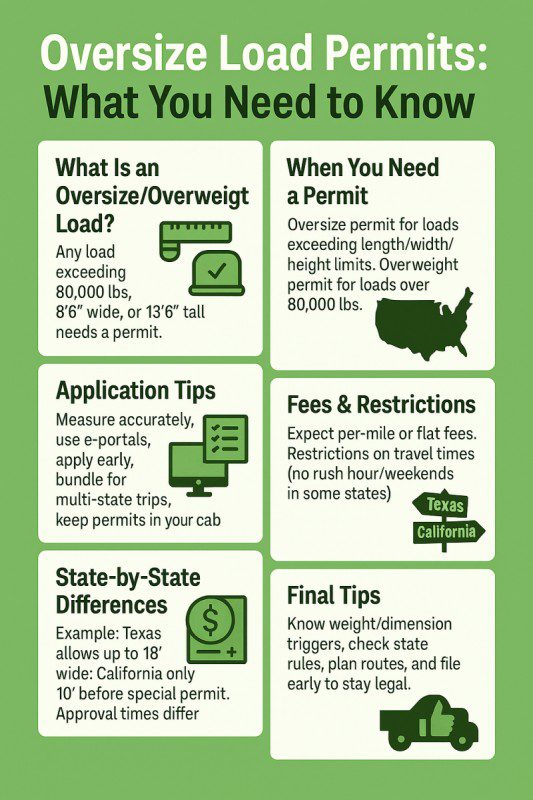Hauling a load exceeding legal dimensions or weight takes more planning than hitching a trailer. Whether you move commercial vehicles, industrial machinery, or modular homes, you must secure oversized and overweight load permits before you hit the road. Missing the proper paperwork can lead to fines, delays, or safety hazards.
Let’s break down what you need to know.
Understanding Oversize and Overweight Loads
Regulators classify a shipment as oversized or overweight once it exceeds set height, width, length, or weight limits. In most states, any rig that weighs over 80,000 pounds without special axle configurations counts as an oversized overweight load. Dimensions usually span around 8 feet 6 inches wide and 13 feet 6 inches tall for unrestricted travel.
Anything beyond those limits — inches or pounds — demands a permit.
When You Need an Overweight Load Permit
If your cargo tips the scales past 80,000 pounds, you must apply for an overweight load permit. States calculate fees based on the extent of the excess weight and the number of axles on your trailer. A typical license covers a single trip on designated highways. Some carriers purchase annual or multi‐trip permits when they run heavy loads regularly. Always confirm whether your state counts gross vehicle weight or axle weight for permit thresholds.
When You Need an Oversize Load Permit
Even if your rig stays under the weight limit, oversized dimensions require an oversized permit. This situation occurs when your trailer’s length exceeds 53 feet, width exceeds 8 feet 6 inches, or height exceeds 13 feet 6 inches. Many states also set maximum overhang allowances for loads outside the trailer’s ends. The process remains similar: submit diagrams, declare dimensions, and pay a fee based on miles traveled.
Combining Oversize and Overweight Permits
Often, your load demands both an oversized and an overweight load permit. In that case, apply for a combined oversized and overweight permit package.
Some state agencies let you bundle them in one application. You save time and ensure you meet all load securement regulations and commercial vehicles rules in one go. Confirm with your state’s motor carrier authority to determine if they issue a single permit or separate documents.
State by State Variations
Permit rules vary widely across jurisdictions. For instance, Texas allows loads up to 18 feet wide with a standard permit, while California limits width to 10 feet before you need a special corridor permit. Lead times also change: Florida might approve an overweight load permit within one business day, whereas New York often takes up to five days for an oversized permit application. Always check each state’s permit office website for the most current rules.
Lead Times, Fees, and Restrictions
Expect fees ranging from a few dollars per mile to flat charges of several hundred dollars per trip. Agencies often require proof of insurance, a route plan, and even proof of compliance with cargo securement rules under FMCSA. Some states restrict travel windows — no oversized or overweight hauls during rush hour, weekends, or holidays. Plan around these windows to avoid hold‐ups at inspection points.
Tips to Streamline Approvals
- Gather precise measurements and weights before you apply.
- Use electronic permit portals where available.
- Apply at least three business days before departure.
- Bundle permits for multi‐state trips in one application when possible.
- Keep all permit documents in your cab and on any in‐cab electronic logging device.
Following these steps helps secure permits quickly and keeps your hauls on schedule.

Oversize Load Permits: Final Thoughts
Moving an oversize or overweight load does not have to feel overwhelming. Knowing when to get an overweight load permit, an oversize permit, or both helps keep operations smooth and legal. Remember that weight thresholds like 80,000 pounds and dimension limits trigger different permit requirements. Check each state’s rules, plan your route, and file early to make every haul successful.





